The following question came up recently on our Facebook page. I was unable to answer it and turned to Mel Vincent, a wildlife rescuer located in Western Australia. Not only does she keep this species herself, but she is fortunate enough to be able to observe many in her own backyard! We are grateful that she stepped in with her expertise to address the uncertainty on line. Thanks so much, Mel!
Q: Do you guys know what part of Australia the dark morph Galah is from? I found two site’s with info about them, one show’s the dark morph and says it’s the western subspecies, but then another breeder’s site show’s the western species and they’re only slimmer, not darker. I really want to know more about my Galah Rosie since I’ve already missed (at least) the first 20 years of her life and the USDA QT information on imported birds is no longer available.
A: That’s a fun question! The person who posted this has been trying to get this question answered on the parrot forums for a while. They’ve hit on a very difficult topic. I say difficult, because there is a lot of conflicting information out there on the subspecies of rose breasted cockatoos/galahs.
Most field guides, medical journals and textbooks all agree that there are at least two subspecies and these are distinguished in part by geography.
The galah is part of the genus Elophus, the species name is roseicapillus. Basic taxonomic protocol means that the first subspecies that was found to exist, is referred to in most texts/articles as the ‘nominate’ species and has a subspecies name that is the same as the species name. So this is the subspecies: E. rosicapiilus roseicapilla (which is commonly referred to as the Eastern Galah subspecies).
Not surprisingly this is the subspecies you’re going to find in the Eastern states of Australia. It is also found in the central and northern parts of Australia. This is the subspecies that is supposed to be more common in the pet trade – but I have yet to see any actual research into that.
The other recognised subspecies is E. roseicapillus assimilis (commonly referred to as the Western galah subspecies). Needless to say – they’re found in Western Australia. Here’s the first piece of contradictory information – there’s actually another subspecies that hasn’t been officially recognised which exists in the north-west of Australia and that is E. roseicapillus khuli (also referred to as the Northern galah). The basic characteristic that separates khuli galahs from the other subspecies is size. Khuli galahs are the smallest subspecies, but otherwise they should look the same as the assimilis.
The textbook definition of the differences between the subspecies focuses on the eyes and colour of the crest. The assimilis has a darker pink crest than the roseicapilla (whose crest is very pale pink – almost white). The periophthalmic ring around the eye is supposed to be grey in the assimilis and pink in the roseicapilla. The assimilis is meant to have a paler rump than the roseicapilla.
I have a 60 year old male roseicapilla galah. He has the almost white crest and the pink periopthalmic rings around his eyes. I’m inclined to believe that 60 years ago, the definition worked.
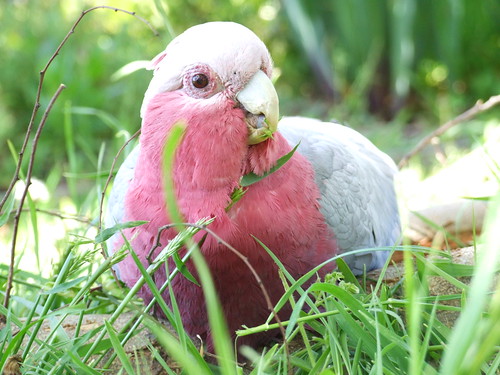
60 year old galah Cocky Boy Photo by Mel Vincent
I have another galah, which my avian vet said he believes is a khuli. He comes from Western Australia. He has a very dark pink crest, very dark pink cheeks and grey periopthalmic rings. He fits the definition of the western species.
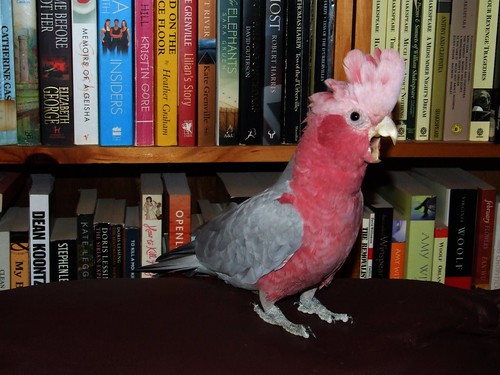
Photo by Mel Vincent
The problem is – that’s a textbook definition and the real world doesn’t always fit in a textbook. Breeders will be trying to keep their bloodlines pure to match that definition but no one told the wild birds that they shouldn’t interbreed with other subspecies.
Consequently, the distinguishing characteristics are getting very mixed up in the wild and the information that is out there is often contradictory.
The different subspecies have largely overcome the geographic separation and have interbred. I have seen both grey and pink periopthalmic rings in the eastern wild birds. In fact, the grey periopthalmic rings seem to be a lot more common. I also have two other much younger pet galahs with almost white crests, that were wild caught (for the pet trade) in eastern Australia. Their periopthalmic rings are very pale grey.
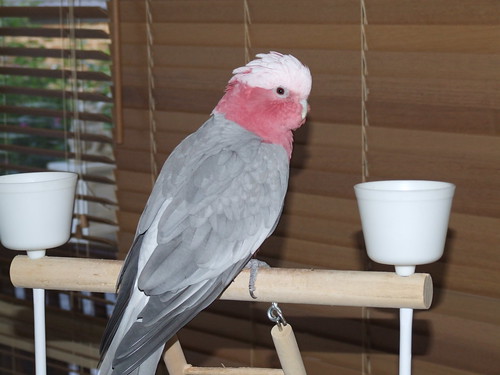
10 year old Morgy, a female roseicapillus. Photo by Mel Vincent
That said though, the periopthalmic rings can change with age, diet, weather… I have photos of all of my birds at different times with different colour rings, lighter/darker grey feathers. I can also say that it seems to be a general rule that the younger the bird the less skin around the eye.
I haven’t seen the darker crest make it into the wild population in the eastern parts of Australia yet, but I have seen the darker cheeks in all of my guys from time to time. The difference is my western galah never loses them. So I tend to look mostly at the crest colour to work out where the bird comes from.
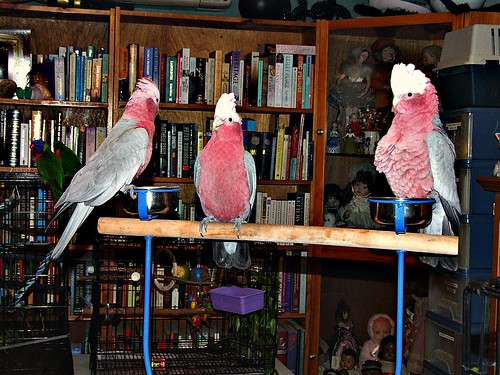
From left Merlin, Nemo and Morgy. Photo by Mel Vincent
In terms of the dark morph – I have seen variations in grey across both eastern and western populations and with interbreeding I honestly don’t know where it originated. It isn’t a defining characteristic of any particular subspecies. The variations in the grey colouring occur naturally, but it is also a characteristic that is specifically encouraged by some breeders. Similarly there is a lutino mutation that is much highly prized in breeding circles (that has a normal galah head but white wings and body). There are other mutations (too numerous to mention here) that people are breeding as well. Most of them are unnatural but galahs do sometimes interbreed with corellas in the wild (another similar native parrot) so it can get confusing!
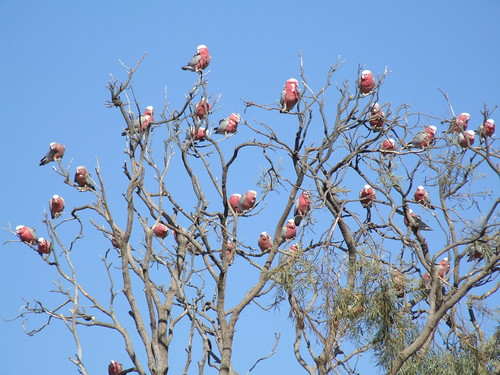
5 Wild eastern galahs Photo by Mel Vincent
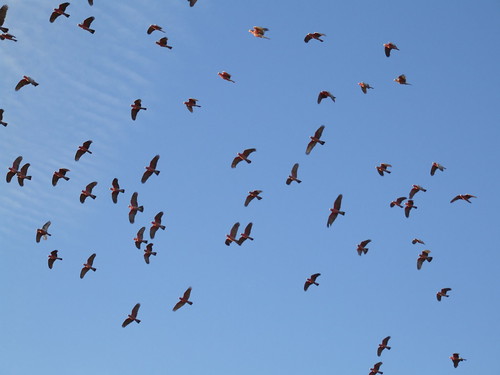
Wild eastern galahs Photo by Mel Vincent
With the way these birds have adapted and spread throughout the landscape, it’s getting to the stage where it is impossible to tell exactly where each one has originated – but the crest colour does give some indication.
Hope that helps!!!
Mel Vincent works as an animal rehabilitator out of Australia.









3 comments
I have a khuli! She’s ASTONISHINGLY dark – every new vet immediately tells me lm killing her liver :C She’s very unique in both Sydney and Victoria – she flew away once and l listed on parrot sites she was very red…and they found her. the chances of finding a lost Australian parrot is almost unheard of.
We have a pair of galahs which have just appeared in our garden today. They have a brownish tone to their grey parts and the pink areas are more intense. One has pink eyes and one has dark eyes so they are obviously a pair and they are starving. The haven’t stopped eating since they arrived. Their colour variations match so I don’t think they are just dirty. Any ideas if they are a natural variation or maybe escapees. Thanks
I enjoyed the article! Thanks for the info. I myself have a young Quaker and am starting to hear a bunch of new sonds from her. Birds are so cute :0) My only problem is that when she starts screaming and screaming. Is there a way to teach her to stop?
Leave a comment